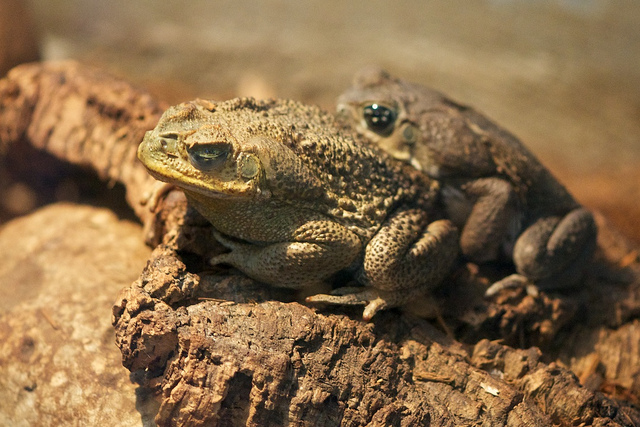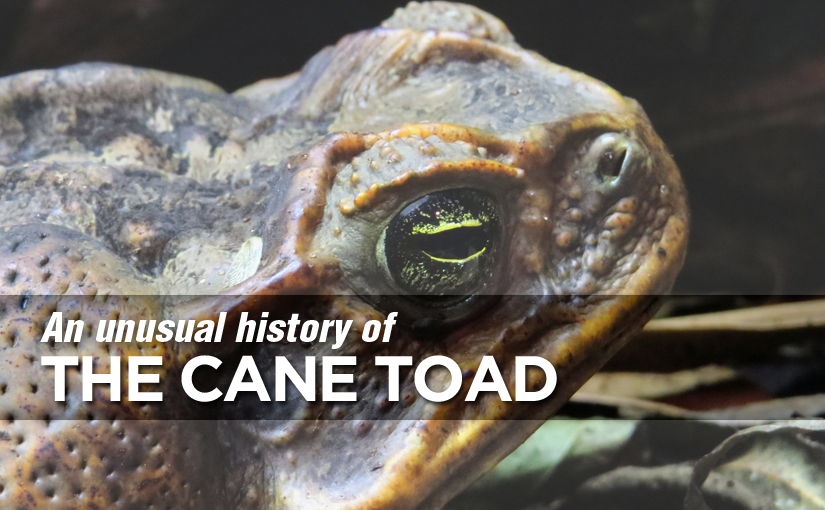Recently I stumbled upon an unusual documentary from the 80s about the giant American toads (Bufo Marinus) of Queensland, Australia. That’s correct. Who would have thought that this 50 minute movie (embedded at the end of this article) with songs of the toad’s praise would turn out to be one of those surprisingly informative and strangely funny movies.
Well, it was certainly fun to watch. Here’s a gist of all interesting things I got from it and some reading which ensued.
Cane toads were never native to northern Australia before the 1930s. Raquel Dexter an entomologist, during the 1932 world conference of sugar technology in Puerto Rico, suggested that the cane toad was the ultimate solution to deal with a native Australian cane beetle. This beetle had decimated the output of sugarcane crop of North Queensland cane farmers.
So, Mungomery Reginald William brought in 102 cane toads into the freshwaters of little Mulgrave river in Gordonvale from Hawaii to tackle the problem of beetle infestation. Mungomery’s intention to make the toads travel for two weeks from Hawaii to Sydney and for another two days to Gordonvale was a noble yet arduous one:
“We have got these bloody grubs by the balls this time and we will go on to bigger and brighter things”
– A jubilant Irishman
But who could have predicted that the toads would lay over 30,000 eggs a season and make their own population explode, eating everything in their way, except for the beetles they were brought in to eat. Mungomery simply did his job well. Yet, nature is a complex machine. I do not remember the last time that we humans tried to tamper the natural order of things and produced a long term effective solution?

Mating: The cane toads involve in this sexual act called Amplexus (grabbing the female with its forearms) where they first attract a female by making deep throaty calls like in the sound clip below, climb on them and grasp them with a firm grip so as to not fall off.
The female then goes into a pond of freshwater and lays a long string of eggs shown below which are then fertilized by the male. The evolutionary purpose for them to lay a huge number of eggs is of course to keep the species alive by increasing the chances of at least a few out of many young ones to survive the big bad world. In a nice little pond in Gordonvale with a handful of animals to prey on these foreigners, however, quite a lot of them end up surviving.

Dumb toads: Cane toads seem to lack basic judgement you would expect from a surviving species. They will try to have sex with a mound of mud, your foot or even a dead female toad on the road for 8 straight hours. Besides sex, they will try to eat anything that they think would fit their mouth, except the cane beetles, of course. Ask the toad if you would like to have a ping pong ball for dinner? Sure, it will say and try to swallow it!
However, the lifestyles of beetles and cane toads never seem to come together. Bettles are usually up in the cane crop, eating it away. While the toads cannot fly. So the very purpose they were brought in for was not ever accomplished. Instead, their population was a menace and they killed quite a lot of dogs, according to Pat White, a cane farmer from Gordonvale.
 Poisonous: These toads have glands under their skin which store a cocktail of venom that when squeezed hard can shoot venom to about one meter away. This venom can absorb through mucous membranes such as eyes, mouth and nose and cause intense pain, temporary blindness, inflammation, or even death to humans and other animals through a cardiac arrest. The seemingly innocuous toad has been held responsible for killing a lot of crocodiles. It has known to kill death adders, kookaburras and what not. The venom however, only comes out when the toad is handled very roughly. Nevertheless, fatal! And yet, some enterprising parents decide that it is ok for their kids to play with these toads.
Poisonous: These toads have glands under their skin which store a cocktail of venom that when squeezed hard can shoot venom to about one meter away. This venom can absorb through mucous membranes such as eyes, mouth and nose and cause intense pain, temporary blindness, inflammation, or even death to humans and other animals through a cardiac arrest. The seemingly innocuous toad has been held responsible for killing a lot of crocodiles. It has known to kill death adders, kookaburras and what not. The venom however, only comes out when the toad is handled very roughly. Nevertheless, fatal! And yet, some enterprising parents decide that it is ok for their kids to play with these toads.
“A recent survey on the Victoria River showed that in a one-year period as many as 77 percent of the crocodiles have died as a result of eating cane toads.”
Professor Keith Christian of Charles Darwin University (The Telegraph)
Like the taste for salt and vinegar chips flavor, the people’s opinion on the cane toad in Northern Australia is very polarized. Most people either hate the guts of this “monster” and pop them like balloons by driving over them, even if it requires them to drive dangerously, or in the wrong side of the road. Others love just adore it, have it as a pet for their kids, make places for them to live, write songs about them and cannot think of a life without them.
A few utilize it as a source of a hallucinogenic drug.
Bufotenin, one of the chemicals excreted by the cane toad, is classified as a class-1 drug under Australian law, alongside heroin and cannabis. The effects of bufotenin are thought to be similar to those of mild poisoning; the stimulation, which includes mild hallucinations, lasts for less than an hour. As the cane toad excretes bufotenin in small amounts, and other toxins in relatively large quantities, toad licking could result in serious illness or death.
One song called Warts ‘n’ all goes:
“If anyone could love a cane toad
It could only be another cane toad
Cos when you love a cane toad
You’ve gotta love him warts ‘n’ all
…”
 Starting humbly from a river side in Gordonvale, the toad population has encroached a vast region in North Queensland and beyond, creating menace like the German army during the world war II. And yet, it continues to brings joy to some and engenders utter distaste among others.
Starting humbly from a river side in Gordonvale, the toad population has encroached a vast region in North Queensland and beyond, creating menace like the German army during the world war II. And yet, it continues to brings joy to some and engenders utter distaste among others.
[youtube https://www.youtube.com/watch?v=6SBLf1tsoaw&w=560&h=315]
